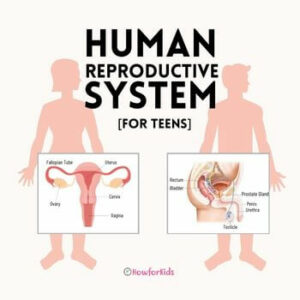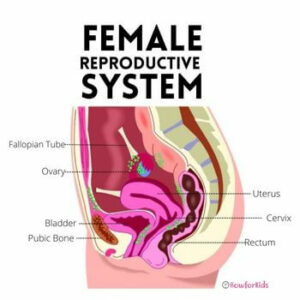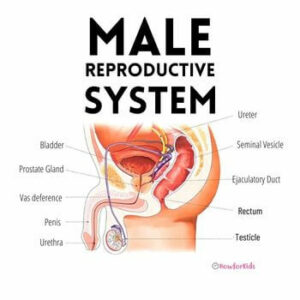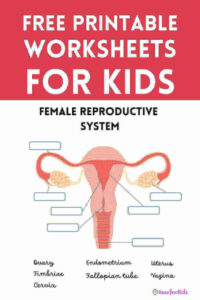the reproductive systems allow the generation of new living beings. Human beings are born with sexual organs that develop at puberty due to the activity of hormones. Puberty indicates the end of childhood and the beginning of adolescence and covers girls from the age of 10 and boys from the age of 11. There are physical changes that are observed in both sexes: Hair grows, height increases, perspiration becomes heavier, and the sexual organs develop.

What does the reproductive system do? Summary
Table of Contents
The reproductive system matures during adolescence and is different in men than in women. In both, sex cells called gametes are produced, which in men are called spermatozoa and in women ovules.
Human Reproductive System
What is Reproduction?
Reproduction is a vital function in living beings. It is the process by which organisms acquire offspring allowing them to give rise to a new life. In humans, reproduction is sexual. This means that individuals of both sexes participate to form a new being: The feminine and the masculine.
In the asexual reproduction of the same cell, two identical cells are obtained.
Human Fertilization
Egg and Sperm Fertilization
The union of the ovum with the spermatozoon is called fertilization, from which the first cell of the new being called the egg or zygote is formed. After fertilization, the egg or zygote reproduces successively and stays in the mother’s uterus during pregnancy. After 9 months when the fetus is fully developed, the baby is born. The embryo is called a fetus when it has a human appearance.
The Female Reproductive System
In both male and female reproductive systems, some of the organs that comprise them are in contact with the outside. They are the external genitalia. While the organs that are inside the abdomen are the internal genitalia.

Female Reproductive System Parts and Functions
The female reproductive system is made up of
- External organs: Vulva
- Internal Organs: Ovaries, fallopian tubes, uterus, vagina.
PDF Free Printable Female Reproductive System: Click here
Vulva
The Vulva has two orifices: Urinary through which the urine comes out and the vaginal orifice.
Ovaries
The ovaries are two. They are oval in shape about the size of an almond and are located in the pelvis.
(lower abdomen) on each side of the uterus. The ovaries form eggs and also produce female sex hormones (progesterone and estrogen). They help prepare the uterus to accommodate the future baby.
Ovum. What is Ovulation?
About once a month a tiny egg leaves one of the ovaries, a process known as “ovulation.” It travels through one of the fallopian tubes to the uterus. In the days leading up to ovulation, estrogens (hormones) stimulate the uterus to line itself with extra blood and tissue. In this way its walls become thicker and prepare for a pregnancy. When the egg reaches the uterus and is fertilized by a sperm, it attaches to the lining of the uterus and gradually develops into a baby.
Fallopian tube
The fallopian tubes are two long, thin tubes that receive the eggs that are produced by the ovaries. Each extends from an ovary to the uterus. If they meet with spermatozoa, fertilization occurs.
How Does the Female Reproductive System Work?
Menstrual Cycle
When the egg is not fertilized (it occurs in most monthly cycles) it does not adhere to the wall of the uterus. Extra tissue that lines the inside of the uterus is removed. The blood, tissue, and unfertilized egg pass through the vagina to be eliminated from the body. It is the menstrual period.
This cycle occurs almost every month for several decades (except, of course, when a woman is pregnant) until menopause: the period in which the ovaries do not release eggs.
What is Menstruation?
The appearance of the menstrual period or menstruation in girls is a sign that she is becoming a woman. At puberty (between the ages of 8 and 13) the girl’s body changes due to the action of hormones that stimulate breast development, among other changes. A couple of years later, when all parts of the girl’s reproductive system are mature, the first menstrual period called menarche appears.

Uterus
It is an organ with muscular walls that the fetus will develop during pregnancy. It joins the vagina through a narrower part: the cervix. Women between the ages of 11 and 50 have their periods. It consists of the fall of the inner layer of the uterus (endometrium). Every month it grows to house an embryo, which if it does not come off and falls in the form of blood that comes out of the vagina.
Vagina
It is a muscular canal that communicates the reproductive system with the outside of the body. It is protected by skin that forms folds called the labia minora and majora. In the area where the labia minora join, there is a very sensitive organ: the clitoris. During intercourse, it allows the penis to deposit sperm. The vagina allows the exit of the baby at the time of delivery.
Male Reproductive System
PDF Printable Male Reproductive System Click here
What are the organs of the Male Reproductive System?
External Genitalia
Scrotum
It is the skin bag that protects the testicles.
Penis
Spongy organ covered in skin. Its flared, conical end is called the glans. The skin that covers the glans is the foreskin.
Testicles
They are protected by a bag made of skin called the scrotum. The testes produce gametes (sperm) and a sex hormone, testosterone. Sperm are transported to the outside by ducts. The liquid that contains them is called semen, which is expelled through the urethra at the end of the penis. The output of semen is called ejaculation in which millions of sperm are expelled.
Urine also comes out through the urethra. The testicles are actually almost outside the body. The temperature of our body does not allow sperm to develop properly.

Internal Organs
Prostate
The prostate is shaped like an inverted pyramid and is about the size of a walnut. It is found surrounding the neck of the bladder and the urethra. It is made up of muscle and glandular tissue.
Seminal vesicles
They are two “bags” that produce the substance that feeds the sperm (semen).
Sperm
They are very mobile and small. Sperm move in large groups (over 100 million at a time). They look like tadpoles with a tail on the back that helps them move.
Epididymis
Sperm are stored in a tube called the epididymis.
Vas deferens
They are tubes or ducts that carry sperm to the penis.
Urethra
It is a conduit shared with the urinary system. Its function is to carry semen and urine to the outside.

